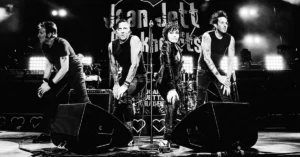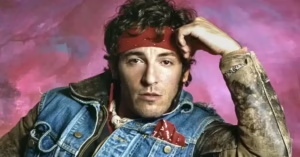KISS: The Rock ‘n’ Roll Spectacle That Shook the World
KISS. From New York Streets to Global Domination
KISS was formed in New York City in January 1973 by Paul Stanley (vocals, rhythm guitar), Gene Simmons (vocals, bass), Ace Frehley (lead guitar), and Peter Criss (drums, vocals). Emerging from the ashes of the band Wicked Lester, KISS combined hard rock with visual excess, quickly distinguishing themselves in the crowded 1970s rock scene with their outrageous makeup, elaborate stage personas, and explosive live shows.

Their vision was simple yet revolutionary: transform a rock concert into a theatrical, comic book-like spectacle, where each member became a larger-than-life character. The band introduced alter egos — The Starchild (Stanley), The Demon (Simmons), The Spaceman (Frehley), and The Catman (Criss) — that would come to define the KISS brand for decades.
KISS. The Makeup of Success: 1974–1977
KISS struggled commercially with their first three studio albums — Kiss (1974), Hotter Than Hell (1974), and Dressed to Kill (1975) — despite relentless touring. But everything changed with the release of the double live album:
Alive! (1975)
This record captured the raw energy of their concerts and propelled KISS into the mainstream. With the roaring success of the live version of “Rock and Roll All Nite,” KISS became a household name.
This period also saw the release of their most iconic studio albums:
- Destroyer (1976) – Featuring “Detroit Rock City,” “God of Thunder,” and the surprise hit ballad “Beth.”
- Rock and Roll Over (1976) – A return to a rawer sound.
- Love Gun (1977) – Included the fan-favorite title track and “Christine Sixteen.”
KISS had not only found their sound — a fusion of glam, hard rock, and pop hooks — but also their image: fire-breathing, blood-spitting, and platform-booted superheroes of rock.
KISSmania: Merchandising and Media
By the late 1970s, KISS had achieved a cultural status few rock bands could dream of. They were pioneers of music merchandising, licensing everything from action figures to lunchboxes, comic books (including a Marvel comic supposedly printed with their own blood), and even a KISS pinball machine.
In 1978, each member released a simultaneous solo album, a bold move unprecedented in rock history. While the albums met mixed critical response, they underscored the brand’s dominance.
That same year, KISS starred in the TV movie KISS Meets the Phantom of the Park — a campy cult classic that epitomized the band’s embrace of theatrical absurdity.
KISS. Unmasked and Under Fire: 1980s Challenges
As the ’70s ended, internal tensions and musical changes led to a series of lineup shifts:
- Peter Criss left in 1980, replaced by Eric Carr.
- Ace Frehley departed in 1982, replaced by Vinnie Vincent (later by Mark St. John, and finally Bruce Kulick).
In a dramatic move in 1983, KISS removed their makeup for the first time during the Lick It Up album cycle. The unmasking was a PR triumph, and Lick It Up marked a commercial resurgence.
Throughout the ‘80s, KISS adapted to the glam metal era with albums like:
- Animalize (1984) – “Heaven’s on Fire”
- Asylum (1985)
- Crazy Nights (1987) – Featuring the power ballad “Reason to Live”
Though some fans missed the original image, KISS successfully reinvented themselves for the MTV generation while retaining their musical edge.
KISS. The Reunion Era: Back in Makeup
In 1996, the original lineup — Stanley, Simmons, Frehley, and Criss — reunited with full makeup and costumes, launching one of the most successful reunion tours in rock history. The Alive/Worldwide Tour was a nostalgic triumph and brought the classic era roaring back.
The band released Psycho Circus (1998), their first full studio album with the original lineup since 1979’s Dynasty. Although Frehley and Criss’s actual studio involvement was minimal, the album was a commercial success.
KISS was now both a nostalgic brand and an active force, alternating between tours with new and classic lineups.
Modern Era: New Faces, Same Fire
After further lineup changes in the early 2000s:
- Eric Singer (drums) and Tommy Thayer (guitar) became permanent members, taking on the Catman and Spaceman personas.
With this new lineup, KISS continued to tour globally and released:
- Sonic Boom (2009) – A hard-hitting return to classic form.
- Monster (2012) – Emphasizing raw, no-frills rock.
Though critics questioned the authenticity of replacements wearing original makeup designs, the band insisted that KISS was a legacy bigger than any single member — a rock-and-roll institution that could transcend generations.
The End of the Road?
In 2019, KISS announced their “End of the Road World Tour,” billed as their final global outing. Extended into 2023 due to COVID-19 delays, the tour ended with a dramatic final show at Madison Square Garden on December 2, 2023.
But even the end had a twist: The band revealed digital avatars of themselves and hinted that KISS would live on through virtual concerts, tribute acts, and immersive experiences — a fittingly theatrical way to transition into immortality.
Legacy and Cultural Impact
KISS redefined what it meant to be a rock band. Beyond the music, they turned concerts into spectacles and elevated merchandising into an art form. Their fans — known as the KISS Army — remain among the most loyal in rock history.
Influences and tributes can be seen across genres:
- Bands like Mötley Crüe, Slipknot, and Ghost cite KISS as key inspirations.
- Their songs have been covered by artists as diverse as Anthrax, Garth Brooks, and The Donnas.
- Inducted into the Rock and Roll Hall of Fame in 2014, albeit amidst controversy about which members were included.
Despite decades of criticism for being “style over substance,” KISS proved that style can be substance when it inspires millions.





